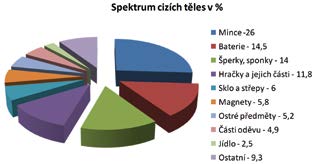Abstract
Introduction: Evaluation of results of the group of paediatric patients treated for swallowed foreign bodies in the digestive tract.
Methods: Retrospective analysis of patients treated for foreign bodies in the digestive tract, managed at the University Hospital of Hradec Králové
between 2011–2018.
Results: 365 patients (182 boys, 183 girls) with a foreign body in the digestive tract have been evaluated. The mean age was 2.4 years. Most of the
children were treated as outpatients (280 children, 76.7%) and only 85 children (23.3%) were hospitalized.
The most commonly swallowed frequent bodies included coins (26%) and batteries (14.5%); sharp objects occurred in 5.2%. Unusual foreign
bodies were noticed, too. We can mention for example a pen or a plant nutrition product. In 302 cases (82.7%) the foreign bodies passed easily per
vias naturales. Endoscopy was necessary in 63 cases (17.2%) – in 51 children the object had to be removed from the oesophagus and in 12 children
the object had to be removed from the stomach. None of the swallowed bodies caused complications such as digestive tract perforation or bowel
obstruction. No patient in the group was indicated for laparotomy to remove the foreign body.
Conclusion: Foreign bodies entrapped in the oesophagus have to be removed endoscopically. In most cases, foreign bodies in the stomach require
only observation in the outpatient setting because they leave the stomach easily, without complications, per vias naturales. If a battery remains at
the same place of the digestive tract for more than 24 hours, endoscopic removal is indicated at our department. In addition, endoscopy is done in
cases of swallowed multiple magnets or bodies that are too large and remain in stomach for several weeks or months. Surgical removal of foreign
bodies should be reserved only for complicated cases.

